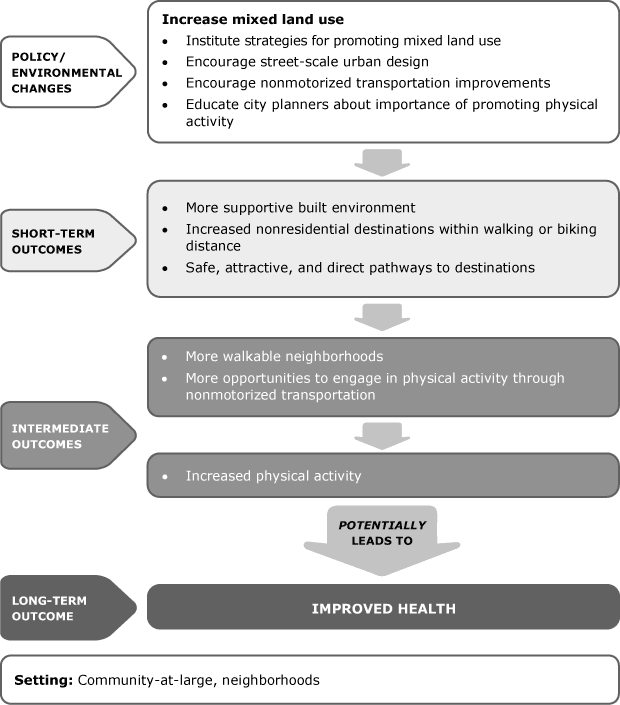Our Healthier Communities
Our Healthier Communities Initiatives are built on the concept that local communities can work together to give all community members healthy choices and support the pursuit of healthy lifestyles. More than 160 Ys are working in collaboration with community leaders to make changes in policies and the physical surroundings in those communities so that healthy living is within reach for individuals of all ages and backgrounds.
Increase Mixed Land Use
When people’s jobs, homes and retail activities are located close together, they are more likely to be physically active. Mixed land use policy interventions can be effective in promoting physical activity.
Research has shown that residents from neighborhoods with better land use mix are more likely to achieve the recommended level of physical activity. Level of physical activity has been found to be significantly related to the number of shops and transit stops in the neighborhood, sidewalks on streets, bicycle facilities and low-cost recreational facilities. In the Netherlands, communities that have increased mixed land use have seen an increased prevalence of walking. Consequently, mixed land use policy interventions can be effective in promoting physical activity. Educating county officials and city planners on the importance of increasing physical activity as a goal in city planning is an important element of this policy/environmental change.
References
- Aytur, S.A. Rodriguez, D., Evenson, K., Catellier, D. Rosamond, W. (2007). Promoting active community environments through land use and transportation planning. American Journal of Health Promotion, 21(4S), 397–407.
- Boehmer, T.K., Hoehner, C.M., Deshpande, A.D., Ramirez, L.K. Brownson, R.C. (2007). Perceived and observed neighborhood indicators of obesity among urban adults. International Journal of Obesity, 31(6), 968–977.
- Frank, L.D., Schmid, T.L., Sallis, J.F., Chapman, J., & Saelens, B.E. (2005). Linking objectively measured physical activity with objectively measured urban form: Findings from SMARTRAQ. American Journal of Preventive Medicine, 28(2) Supplement 2, 117–125.
- Heath, G.W., Brownson, R.C., Kruger, J., Miles, R., Powell, K.E., Ramsey, L.T., and the Task Force on Community Preventive Services. (2006). The effectiveness of urban design and land use and transport policies and practices to increase physical activity. Journal of Physical Activity and Health, 3(S1), S55–S76.
- Saelens, B.E., Sallis, J.F., Frank, L.D. (2006). Environmental correlates of walking and cycling: Findings from the transportation, urban design, and planning literatures. Journal of Physical Activity and Health, 3(S1), S55–S76.
- Sallis, J.F., Bowles, H.R., Bauman, A., Ainsworth, B.E., Bull, F.C., Craig, C.L., Sjostrom, M.,...Bergman, P. (2009). Neighborhood environments and physical activity among adults in 11 countries. American Journal of Preventive Medicine, 36(6), 484–490.
Salvesen, D., Evenson, K.R., Rodriguez, D.A., Brown, A. (2008). Factors influencing implementation of local policies to promote physical activity: A case study of Montgomery County, Maryland. Journal of Public Health Managem
More Healthy Living Strategies
-
Active Living Strategy #2
Healthy Living Strategies
-
Active Living Strategy #3
Healthy Living Strategies
-
Active Living Strategy #4
Healthy Living Strategies